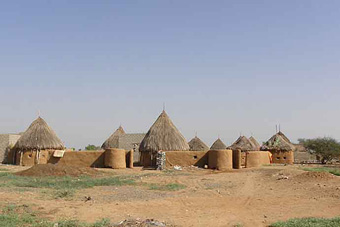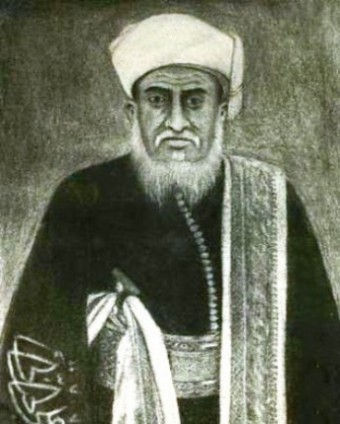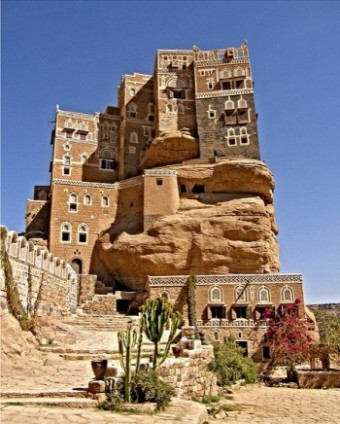This page is part of a project that looks at the Jews of Yemen whose history, in this area, dates back for thousands of years. In order to provide a context for this project, an effort has been made to supply the reader with general background information about the geography and history of Yemen.
Also in the Jews of Yemen Docuweb:
 Relations with
Relations with
their Local Neighbors
________________
 Personal Stories
Personal Stories
________________
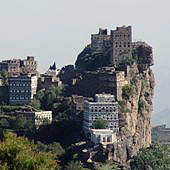 A Brief Background
A Brief Background
About Yemen
________________
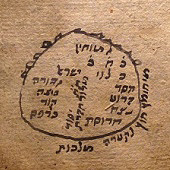 Links with
Links with
Other Jewish Centers?
________________
 Customs, Culture and
Customs, Culture and
Folklore
________________
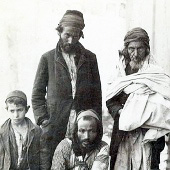 Early Immigration
Early Immigration
________________
 Kinneret and Yemenite
Kinneret and Yemenite
Pioneers
________________
 When did the Jews
When did the Jews
Arrive in Yemen?
________________

Yemenite Jews &
American Colony
________________

Missing Children
Affair
_______________
 Jewish Scholars
Jewish Scholars
of Yemen
________________

Operation 'On Wings
of Eagles'
________________
| A Brief Background About Yemen
Yemen is currently considered an underdeveloped country. Still it is blessed with one of the richest and most vibrant histories in the Middle East, with archaeological findings dating back to the biblical period. It is located in the strategic southwest of the Arabian Peninsula and is rich with a varied topography and climate. It houses a diversity of many hundreds of tribes that have kept their distinct characteristics throughout the times.
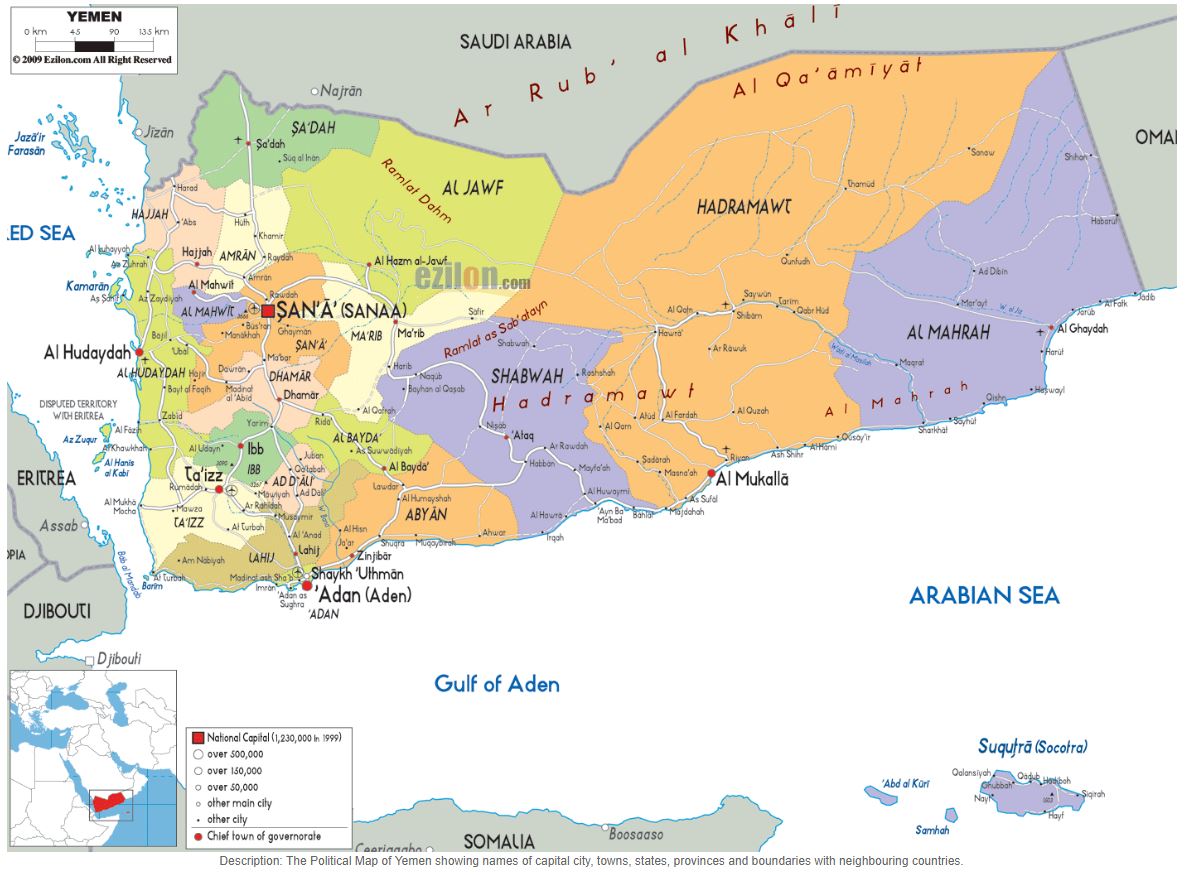
Geographical Zones of Yemen
Question: Where is Yemen located?
Answer: Yemen is located in the south-western corner of the Arabian Peninsula. It borders Saudi Arabia in the north, Oman in the east, the Red Sea in the west and the Gulf of Aden in the south.
Babb-el-Mandeb strait is the link between the Red Sea and the Gulf of Aden. Yemen holds the north bank of the strait, while Somalia, in the horn of Africa, holds the south bank. The strait, some 20 miles in width, is one of the most strategic shipping lanes in the world. Yemen also possesses more than 200 islands of which the most famous is Socotra.

Yemen is the highest country in the Arabian Peninsula, with an average elevation of about 2,000 meters. It can be roughly divided into four geographic zones.
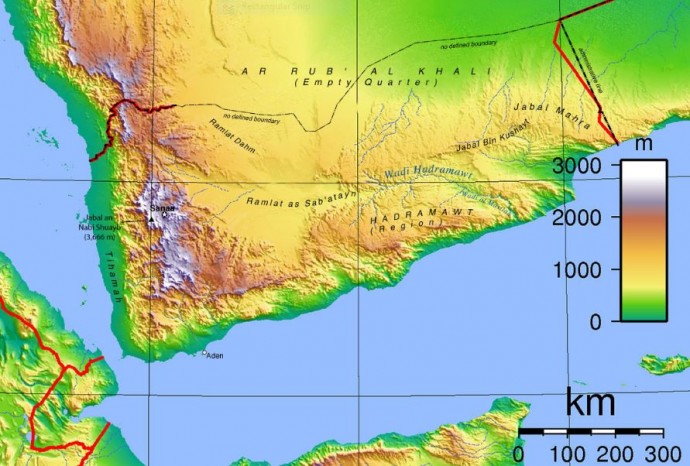
- Tihamah is a stretch of semi desert plain, some 50 to 80 km. in width, which starts along the Red Sea. It is mostly sandy but contains spots of desert shrubs. It is a hot uninviting land with extremely high temperatures. Some consider it as the hottest spot on earth. The Tihamah stops abruptly at the foot of the western highlands.
- The western highlands is the highest area in Yemen with over 3000 meters above sea level. Jabal an Nabi Shuayb (3,666 m; 12,028 ft) the highest spot in Yemen, is located here. Sana’a, Yemen’s capital, is situated only a few dozens of kilometers east, about 2200 meters above sea level. The western highland receives the most rainfall in the Arabian Peninsula, ranging from 100 mm. per year to over 1000 mm. in the Ibb region. This resulted in the development of extensive agriculture in the valleys and in the mountains slopes that are intensively terraced.
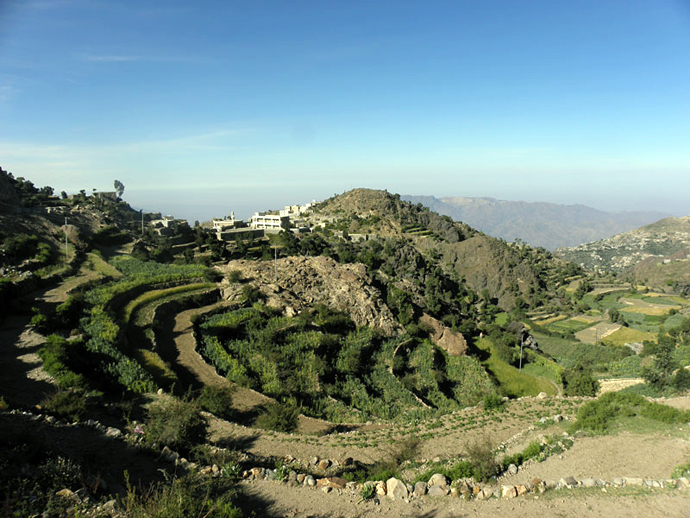
- The central/eastern highlands gradually descend towards the east, but is still an extensive high plateau between 1000 to 2,000 and more meters in elevation. This area is drier than the western highlands because of rain-shadow influences, but receives sufficient rain in wet years for extensive cropping. Water storage allows for irrigation and the growing of wheat and barley.
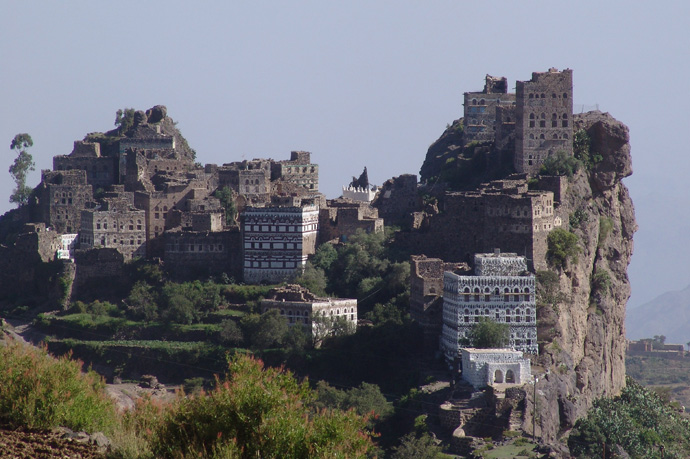
- Rub al Khali in the north-east, is considered the largest contiguous sand desert in the world. The desert covers some 650,000 square km. (250,000 sq mi), including parts of Saudi Arabia, Oman, the United Arab Emirates, and Yemen.

Population
Mountains, with difficulty of access, and a desert belt that surrounds them has kept the population in Yemen relatively isolated, thus allowing them to maintain tribal-based societies with their own distinct cultures. On the other hand, Yemen’s strategic location on the shore of the Indian ocean and along the Red Sea, allowed for immigration and the settling of minority groups from Africa, India and other parts of Asia, thus creating a variety of ethnic groups.
The larger ethnic groups of Yemen are primarily Arabs. Among the minority groups one can find Afro-Arabs, South Asians and some Europeans, most of which have left Yemen in the last few dozens of years due to the political changes.
Some of the ethnic groups include about 400 Zaidi tribes, who live in the highlands of the north, the discriminated city-dwellers Akhdan caste, Yemenites of Persian origin, Indonesians, Malaysians, Indians, Singaporeans, and the Jews who have almost entirely left in recent years. Among the two million Hadhramaut Hadhrami people, there are some 1,300 distinct tribes.
As of 2014 Yemen’s population was estimated to be about 24 million. Due to a high fertility rate of about 4.45 children per woman it is believed to increase to about 60 million by 2050.
History – From Ancient Yemenite Kingdoms to Modern Conflicts
The history of Yemen is so rich that it is impossible to cover everything within the scope of this Docuweb. We hope to offer a glimpse of this vast history in the hope of providing a background for the various topics that are included in this project.
Ancient
While not much researched, remains of ancient cultures can be found in many areas of the highland regions of Yemen. Some of them relate to the Bronze Age and earlier. Owing to its location off the shores of the Indian Ocean and the Red Sea, Yemen served as an important junction along the trade routes between east and west. It functioned as one of the older centers in the ancient Near East. The climate in the highlands and the relatively high precipitation there allowed for an intensive agriculture and extended population to grow.
Ptolemy, the Greek geographer, noted this and described Yemen as the Fortunate Arabia or Happy Arabia.
From the 8th century BCE until the 6th century CE, a few dozens of years before the appearance of Islam, the different regions of Yemen were ruled by a number of kingdoms.
These monarchies sometimes cooperated with each other and occasionally fought when conflicted interests emerged. They were in control of the incense and spice route and a substantial amount of it was grown there. The main kingdoms during this period were Saba, Main, Qataban, Hadhramawt, Awsan and Himyar.
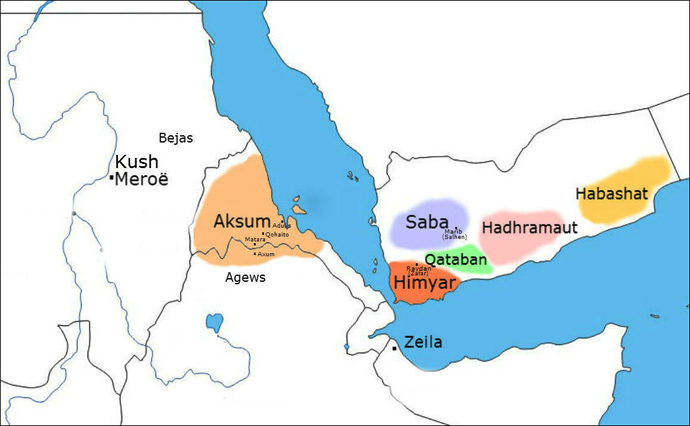
During their prime, the various kingdoms of Yemen extended in the north-east, including the territory of current Oman, in the north-west of current Saudi Arabia, as far as Dedan, and in the west including the horn of Africa, Ethiopia and stretching down to what is today Tanzania.
Ancient Kingdoms in Yemen
List of the kingdoms in Yemen’s ancient history with estimated time periods:
- Kingdom of Saba (8th century BCE – 275 CE)
- Sabaean hegemony (800 BCE – 400 BCE)
- Kingdom of Ḥaḑramawt (8th century BCE – 300 CE)
- Kingdom of Awsan (800 BCE – 500 BCE)
- Kingdom of Qatabān (4th century BCE – 200 CE)
- Kingdom of Ma’in (8th century BCE – 100 BCE)
- Kingdom of Ḥimyar (2nd century BCE – 525 CE)
- Kingdom of Aksum (520 – 570 CE)
- Sassanid period (570–630 CE)
It has been suggested, although not without dispute, that the Kingdom of Sheba (Saba), was located in what is defined today as Marib Governorate, in the central highlands of Yemen, with the city of Marib as its Capital. The city of Marib is situated some 120 km east of Sana’a. The kingdom is dated roughly to between 1200 BCE until 275 CE. The kingdom fell after a long civil war between several Yemenite dynasties, resulting eventually in the rise of the Himyarite kingdom.
The kingdom of Sheba flourished from the 8th century BCE for a few hundreds of years. Extensive water systems were built by the Sabians; the most famous one being the dam of Marib. Intensive commerce emerged with incense and spices playing a substantial role.
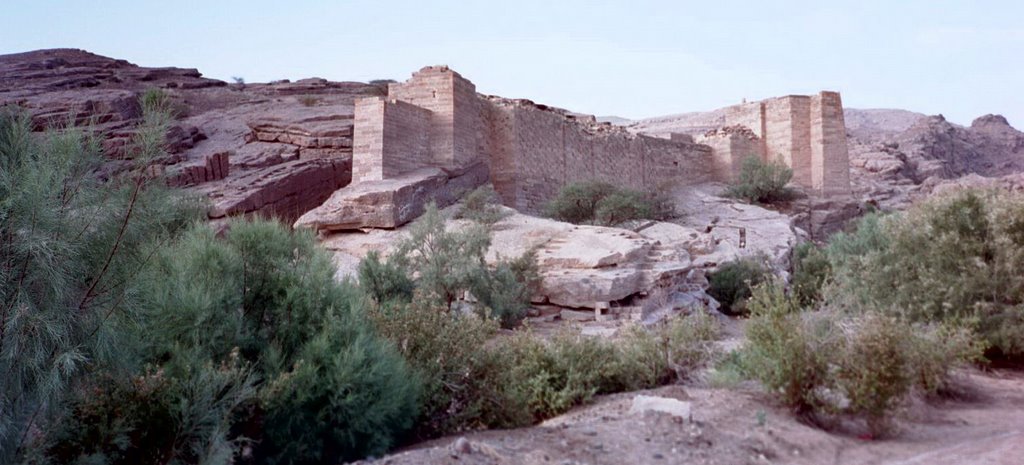
Most researchers identify the Kingdom of Saba with the biblical kingdom of the Queen of Sheba (Saba) who visited King Solomon in Jerusalem. The final conquest of Saba by the rising power of Himyar occurred in 275 AD.
The Himyar Kngdom was located in the strategic south-west corner of the Arabian peninsula. It performed the final conquest of Saba, which was bordering it in the north, in 275 AD. It did not take long before it took over the other kingdoms in the north and the east. At a certain point at its peak, the King of Himyar, Abu-Karb Asaad, influenced by the Jewish religion, converted to Judaism around 400 CE. From then on, the status of the Jewish community strengthened and reached its peak under the last of the Himyarian kings, Du’Nuas until 525 AD.
The years to come, until the birth of Islam, saw the kingdom changing hands between the Byzantine Empire and its ally, Christian Ethiopia. Both hoped to establish a strong Christian influence in the Arabian Peninsula and to contain the Himyar forces that rebelled against the Christian regime. The Sasanian, known also as the Neo-Persian Empire (pre-Islamic period), took over the area until the conquest by the forces of the new emerging Islam religion in 629.
The Middle Ages Witness the Appearance and Force of Islam
Muhammad, the prophet of Islam, was born in Mecca in Arabia (currently Saudi-Arabia) in about 570 AD. His new ideas were not accepted by the ruling factors there.
In 622 AD he fled with his followers from Mecca to Yathrib, later known as Medina. There he established a more stable infrastructure that served as a base for his later conquests. Muhammad died in 632. At that point the Arab Peninsula was already in the hands of the new religion.
The period after Muhammad between 632 to 661 AD was ruled by the Rashidun (Rightly Guided) Caliphs.
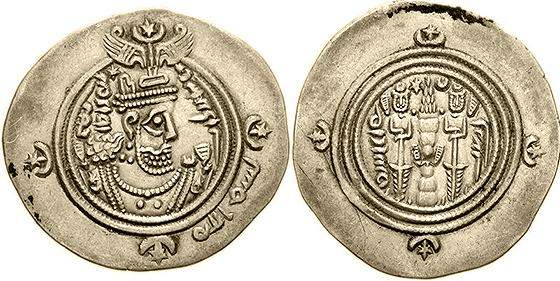
Image source: https://en.wikipedia.org/wiki/Rashidun_Caliphate#/
Muhammad, claiming that he is the last of the prophets, did not want to appoint a successor. His close milieu, being aware of the fact that the loyalty of the followers was given more to Muhammad the person rather than to the ideas that he preached, were worried that with his death the new religion would disappear. As a result his successors from 632 to 661 AD where elected from his closest family relations. The classic written sources of Islam consider the 4 Caliphates of that period as those that lay the moral base of Islam.
Emergence of the Shia
Only a few dozens of years after the birth of Islam, a new branch – the Shia – emerged. It recognized only the 4th Caliphate of Ali ibn Abi Talib, who was Muhammad’s cousin and also the husband of his daughter, as the true successor of Muhammad.
The originator of this branch was his son, Hussein. He was murdered together with some 70 members of his family in Iraq by Sunni forces – the main stream of Islam.
Since his murder, the Shia celebrate the Day of Ashura in memory of this and other incidents of Shia persecution by the Sunni majority. The celebrations include hitting themselves until bleeding. Currently the Shia represents approximately 20% of the Islam world and currently it does not look like that there is a ground for reconciliation between the two divisions.
By 661 AD, at the end of the Rashidun (Rashdun) Caliphs period, Islamic conquests reached what is today Syria, East Turkey, Afghanistan, Iran, Iraq, Israel, Lebanon, Jordan, Egypt, Libya and more.
Islam Reaches Yemen
The appearance of Islam, in the 7th century, occurred when Yemen was occupied with conflicts and alliances among the different dynasties that were already in a process of decline. The conquest of Yemen by Islam therefore happened with relatively moderate resistance. Moreover, some Yemenite forces played an important role in spreading and supporting the expansion of Islam.
During the 3rd period, ruled by the Umayyad Caliphs (661-750 AD), Islam was still on the move. The conquests extended east and west and, in Europe, they conquered Spain.
At a certain point Damascus in Syria became the center of the new Empire. The Empire was divided into provinces that dealt each with its own administration. The governor of each province was appointed by the Caliph in Damascus. Left-over tax money was sent to the control center located in Damascus. In general, other non-Muslim monotheistic religious minorities, like Jews and Christians, had to pay an annual tax per capita, known as Jizya, for protection.
Abbasid Caliphs (750-897) – A Time of Intellectual Flourishing
Throughout Yemen's history, local dynasties popped up due to the topography that was difficult to access and control and due to the variety of tribes and the sense of independence that they possessed. These factors made it nearly impossible to maintain a central administration for long periods of time....The Abbasid dynasty, stationed in Bagdad, took control of the Islamic Empire from the Umayyad Caliphate in the mid 8th century. For Islam, this was a period of intellectual flourishing which continued to about 1000 AD. Some will define it as the golden age of Islam. This period is characterized by the development of language and culture in Islam, by the rich literature and the development of sciences. During this period the Greek, Roman Persian and Aramaic mythologies were translated into Arabic.
One of the most famous scholars in Islam that emerged during the Abbasid Caliphate was Abu Yusuf Ya‘qub ibn Ishaq, known as Al-Kindi (801-873 AD). He was born in Basra, and educated in Bagdad, Iraq. Al-Kindi with other scholars translated into Arabic works of Aristotle, and other Greek philosophers, mathematicians and scientists. As a person that excelled in many fields like philosophy, medicine, music, astronomy, pharmacology, psychology and many more, he wrote dozens of books and left a great impact, beyond the Islamic world, during his period and along the centuries to come.
Yemenite provinces, while accepting Islam and actually being supportive in spreading it, remained in many cases somewhat less controlled by the central Caliphate administration due to the tribal sense of independence and individuality that they acquired in the fragmented highlands of this area.
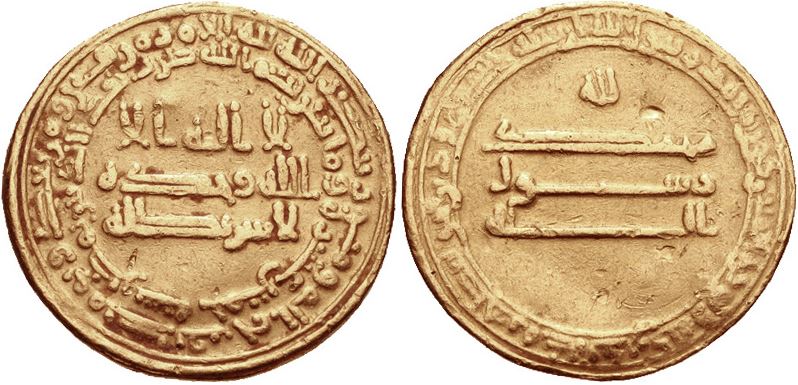
Ziyadids Caliphate (818-1018) – Religious Divisions – Shia Gain Influence in Yemen
In 818 AD Muhammad ibn Abdallah ibn Ziad was appointed by the Caliph, al-Ma'mun from Bagdad, to restore law and order in the unstable Yemeni provinces....With the aid of his Sunni Ziyadid tribes he controlled the coastal area, the Tihama, and established the city of Zabid as its capital in the west. Then, through compromises with the tribes in the highlands, he expanded his influence over most of Yemen, including Hadramawt and part of the uplands. At the end of the 9th century the Zaydiyyah movement took hold in the highlands of Yemen as a result of discontent due to the oppressive treatment by the Abbasid caliphates that were ruling from Bagdad. The Zaydiyyahs associated themselves with the Shia branch of Islam, but formed a new Shia sect claiming that the leader of the Muslim community should only be a descendant of Muhammad through his daughter Fatimah. While the main stream of the Shia claim that a leader, the Imam, should display qualities like justice, bravery, wisdom, piety, knowledge and so forth; the Zaydis were less strict about this and emphasized the practical and religious qualifications in the leader.
Najahids (1022-1158) – From Slavery to Overlords
At the end of the 10th early 11th Century, the Ziyadids became increasingly dominated by an African group, the Najahids, who were originally slaves....The Najahids took over the Ziyadids capital Zabid, located in the Tihama in the western coastal plain, and ruled the region for over 130 years.
Eventually collaboration formed between Ziyadids and the Mahdids tribes, who were able to assassinate the Najahids leader Surur, thus marking the end of the Najahids dynasty.
Sulayhids (1047-1138) – A Dynasty of Native Yemenites – Successful Rule by a Woman
The Sulayhids, native Yemenites, established their dynasty in the highland of Yemen at around 1047 AD. They gained their independence while the Najahids were still in power in the Tihama....The Sulyahids took over the Tihama lowland from the Najahids in approximately 1060, which allowed them to arrive later to the strategic shore of Aden. The ruler, Ali as-Sulayhi, formally ruled in the name of the Fatimid caliph in Cairo. He was killed by the Najahids and his son took over. After the son’s death, the dynasty was ruled by the son’s widow, Arwa al Sulayhi, who turned out to be the greatest ruler of this dynasty. While she was not the only female ruler in the Arab world, she was the first woman to be accorded the important title of Hujja in the Isma’ili branch of Shia Islam, suggesting that she was the closest living image of God’s will in her lifetime. The dynasty ruled first from Sana’a and later Dhu Jibla is now regarded as a world heritage site. The Sulayhids died out in 1138 with Queen Arwa’s death. Their position in Sana’a was taken over for a while by the Hamdanid Sultans (until 1174)
Zurayids (1083-1174) – A Tribal Dynasty in the Flourishing City of Aden
The Hamdan tribe started ruling Aden on behalf of the Sulayhids. The grandson of Karam Al-Yami Zuray, who gave the dynasty its name, ruled together with his uncle al-Mas'ūd. They took part in the Sulayhid battle against the Najahid capital Zabid and were both killed during the siege (1110)....Their respective sons refused to pay taxes to the Sulayhid Queen Arwa al-Sulayhi. Although they were defeated by Sulayhid forces, Queen Arwa agreed to reduce the tribute by half, to 50,000 dinars per year. The Zurayids again failed to pay. This time the annual tribute from the incomes of Aden was reduced to 25,000. Later on they ceased to pay even that since Sulayhid power was in decline. From that point the Zurayids experienced a few dozens of years of independent rule in the city, vibrant with international trade of goods such as textiles, perfume and porcelain, with North Africa, Egypt, Iraq, Oman, Kirman and China. After the death of Queen Arwa al-Sulayhi in 1138, the Fatimids in Cairo kept a representation in Aden, adding further prestige to the Zurayids. Their period ended with the appearance of the Ayyubids in 1174 AD.
Ayyubids (1174–1229) – The Kurdish Influence – Part of the Great Salah ad-Din Conquest
The Ayyubids were Sunni Muslims of Kurdish origin. Their dynasty was founded by Salah ad-Din who also led the campaign against the Crusaders in the east Mediterranean. In his prime, Salah ad-Din dominated Egypt, Syria, upper Mesopotamia, Hejas, Yemen, and parts of north Africa....The Ayyubids invaded Yemen, due to its strategic location, for the trade route from the Far East to Egypt and Europe. They succeeded during their 55 years in power in Yemen, unlike other dynasties, to have a better control over the fragmented land, due to a forceful and efficient army. Members of the Ayyubids family were appointed to rule Yemen until 1229. However, due to their frequent absence from the country, they were eventually replaced by the Rasulids. Still they had an important impact by being able to unite large areas of Yemen. Their policies regarding the ownership and control of land led to a division that has lasted ever since – the coast and southern highlands with greater part of Sunni practicing the Shafii school of Islam, and the upper and highlands with a majority of Zaydiyyah that practice the Shiite branch of Islam.
Rasulids (1229–1454) – A Turkoman Soldier is Recognized as Sultan in Yemen
When the last Ayyubid ruler left Yemen in 1229, he appointed Nur ad-Din Umar, a member of the Bani-Rasul group of soldiers of Turkoman origin, as his representative....He received an independent position and was recognized as a sultan in 1235 by the Abbasid Caliph in Cairo. Under their rule most of Yemen became a strong entity politically, economically and culturally. The Rasulids’ dynasty flourished over the duration of some 230 years. Many sultans of this dynasty had an open mind. They were interested in science and were skilled in medicine, agriculture, legislation, linguistics and culture. Extensive trading enriched the treasure. Schools, mosques, water systems and roads popped up everywhere and some of the projects extended as far as Mecca.
Although confrontations with the Zaydiyyah and its allies occurred from time to time, it is the rivals from within, claimants for the throne, who were the reason behind the downfall of the dynasty in the years to come.
Tahirids (1454-1517) – A Dynasty of a Powerful Native Family Under a Mamluk Caliphate
The decline of the Rasulids dynasty cleared room for a powerful native family on the rise - the Bani Tahir family....Under their name, the Tahirids Dynasty was formed and took over the regime in 1454. They were in office only some 63 years. The Bani Tahir followed the pattern of the Rasulids with its extensive building and development in many cities like Aden, Zabid, Rada and many more. They did not have the ambition to expand beyond Yemen. As a result of occasional wars with the Zaydi Imams they were never able to occupy the highland completely. During this period, the ruling Caliphate was the Abbasid Mamluk Caliphate in Egypt. They had deep concerns regarding a possible control of the southern Red Sea by the Portuguese, and started to send seaborne expeditions to that area. Initially the Tahirids supported the Abbasid Mamluk Caliphate. Later on they refused to support them. In response, Mamluk forces attacked the Tahirids in 1517 AD and killed their leader, Sultan Amir the 2nd. Although they lost this battle, the Tahirids kept on resisting the Mamluks until 1538. The Tahirids fall marked the end of the Sunni hegemony in Yemen.
First Ottoman Period (1538-1635) – Conquest over the Mamluks and Occupation of Yemen
Soon after the Mamluks victory over the Thahirids in Yemen in 1517 AD, they lost their central base and administration in Egypt to the Ottomans led by Selim I and consequently they lost their strength in Yemen....The Zaydis exploited the opportunity and expanded their territory. The Mamluk garrison accepted the new force, and were contained in a small area in the Tihamah.
In 1538 the Ottoman forces arrived in Yemen. They were concerned with the Portuguese presence in Socotra, one of the most important islands south of Yemen, which was usually under the administration of Aden. They replaced the current administration in the areas they conquered, including Aden, and set their own management center in Zabid.
After a few campaigns against the Zaydis in the highlands of Yemen, Sana’a was taken by the Ottomans in 1547. Oppression and misruling on behalf of the Turks triggered a constant resistance against them by the Zaydis to a point that the Turks were almost expelled from Yemen. The Turks succeeded to defeat the Zaydis and, following this, enforced harder measures on the Zaydis and promoted the Sufis Ismailis as a counterweight.
The Ottomans first occupation in Yemen lasted until 1635. The Yemenites never accepted this foreign rule that was accompanied with cruelty, injustice and over taxation. The Zaydis defined the Turks as “infidels of interpretations” and appointed a new Imam in 1597, expecting him to fulfill his obligation under their doctrine and to rebel against an illegal ruler. The Imam, al-Mansur al-Qasim and his successor expanded their territory gradually until the Ottomans eventually had to leave their last strongholds in Yemen.

The Bridge of Sighs (not to be confused with the one in Venice, Italy) also known as Shaharah Bridge, was built in the 17th century in order to ease the resistance against the Turkish invasion. it is located about 140 KM north of Sana’a at an elevation of 2600 meters above sea level and constructed some 200 meters above the bed of the Kenyon that separates the two mountain ranges, Jabal al Emir and Jabal al Faish.
Qasimids (1597-1872) – End of the first Ottoman Occupation – Yemen flourishes
The Qasimids are named after their founder, the Imam al-Mansur al-Qasim. They are related to one of the Rassid branches belonging to the Zaidiyyah branch of Shia Islam....After expelling the Turks, Al-Mansur’s successors were able to group Yemen under his rule, set an independent political entity and form diplomatic relations with countries in the Indian ocean and with Ethiopia.
The regular annual pilgrimage caravans to Mecca were re-established, and an effort to encourage a sense of unity between Sunni and Shi’a Muslims was made. At that point the imams ruled a vast territory, from Aden in the south, close to Dhofar in the east, and north of San’a. Yemen flourished at that period in terms of commerce. European businessmen built factories in Yemen after the Turk’s withdrawal and the port city of Mocha became an important point for the coffee trade that was also grown in the highlands of Yemen with great success.
The imams of the Qasimids dynasty succeeded each other with a relatively easy process, owing to the fact that they applied Turkish style administration and reserved a standing army. Although most of the regions were ruled by their family members, nevertheless they became more and more independent with time.
The power of the imamate was therefore bound to decline. This happened during the late 17th , 18th and 19th century.
Reasons for decline included conflicts among the Qasimid branches and tribal unrest. In addition theological differences were raised in the 18th century since the Qasimids practiced legal reinterpretations to Islam and were accused of illegal innovations. These and more affected the dynasty, which was weakened and shrunk in size.
The Qasimids lost one of the biggest tribes in the south of Yemen – the Yafi tribe. According to Al Hamadani, a famous Arab genealogist, this tribe is descended from the ancient Himyarite kingdom. Aden was also liberated in 1731. The profitable coffee industry and trade diminished due to the fact that it started to be produced elsewhere in the world.
The imams themselves, adopting the style of Middle East monarchies, became increasingly distant figures for their subordinates. Consequently, they gradually lost the respect of their subjects and the moral and physical support among the tribes of Yemen.
The Tihama was already held by Egyptian forces and therefore was not in the hands of the immams for a while. The Imamic state got another blow with the invasion of the Wahhabis during the early 1800s.
With the second appearance of the Turks in 1849 in the Tihama, and later in 1872 in the highlands of Yemen, one can mark the end of the nearly 300 years of the Qasimids dynasty.
Second Ottoman Period (1872-1918) – Part of a Game for Greater World Power
The Ottoman Empire reestablished its interest in Yemen and the Red Sea area for the second time in the middle of the 19th century. This interest was due to the increase of the world trade following the development of technology, improved means of transportation and possible cheaper and faster connections to the Far East with the expected opening of the Suez Canal (1869)....They were not alone – France, Egypt and Britain also had colonial interests for the same reasons.
The Ottomans also wished to diminish the influence of the British who occupied Aden in 1839. Chaos and a weak political environment in Yemen at that time played in their favor and, with the help of some Zaidi tribes, they took over Sana’a. Resistance of other Yemenite tribes never ceased because they rejected the modern tools of administrations that the Ottomans tried to enforce. Consequently, there was never an absolute control by the Turks over Yemen. It reached a point where the former allies of the Zaidi groups were recognized by the Ottomans as a kind of an independent entity that would collect their own taxes, while the Turks would collect from their Sunni subordinates.
Due to territorial conflicts in Yemen, the Ottoman Empire and Britain defined, in 1902, the lines of influence between them. These lines where the foundation for the later division of Yemen into two separate entities that lasted until 1990. The agreement regarding the division was signed in 1914, the same year that the 1st world war started. Eventually, as a result of this war that ended in 1918, the Ottomans pulled out of Yemen completely.
Short Notes on the Modern History of Yemen
The withdrawal of the Ottoman Empire in 1918 marked what is considered to be the beginning of modern history of Yemen. The northern part of Yemen gained freedom with the disappearance of the Ottomans. The imams that ruled the north of Yemen for the decades to come until 1962 emerged primarily from Zaydies.
Imam Muhammad Yahya
Imam Muhammad Yahya gained control in 1904. The Ottoman approach was to let the Zaydi imams deal with the internal affairs while the Ottomans, as the dominant power, controlled the foreign relations. Imam Yahya strengthened his control over northern Yemen after the Ottomans, creating the Mutawakkilite Kingdom of Yemen (1904-1962).
Left: Imam Yahya Portrait. Image Credit: Globaltab.net.
Right: Imam Yahya Summer Resident. Image Credit: Antti Salonen
From 1934 until his assassination in 1948, Yahya redirected his energies toward internal consolidation of his authority and the creation of a viable central government.
Control was strengthened by the founding of a standing army and by appointing his sons as governors of key provinces.
Yemen joined the Arab League in 1945 and became a member in the United Nations in 1947.
Imam Yahya, was murdered in 1948 in an unsuccessful coup attempt. His son Ahmad bin Yahya took over. During his time, until 1962, when he died, Yemen went into a period of even greater oppression over his subordinates. This period included unrest, renewed conflicts with Britain over their control in the south of Yemen and increasing support of Arab nationalist’s agenda led by the Egyptian leader Gamal Abdul Nassar.
Ahmad – Son of Imam Yahya
Shortly after gaining power, Ahmad’s son was overthrown by revolutionary forces that took over Sana’a and created the Yemen Arab Republic. The new entity was assisted by the Egyptians who supported them militarily and economically. Saudi Arabia and Jordan supported the royalist’s army that opposed the newly created republic, resulting in the North Yemen civil war that continued periodically until 1967, the year that the Egyptian army left. The next three years signified gradual reconciliation among the rivals and in 1970 Saudi Arabia recognized the Republic of Yemen in the north of Yemen with Sana’a as it’s capital.
During this period, South of Yemen was still under British control, which started in the 19th century in the Aden area. In 1964 the British announced their intention to hand over their area of control to the existing entity in the south of Yemen – The Federation of South Arabia. This was done in 1967 but not without violence. A rebellion in the Federation of South Arabia Army, which also spread to the police, required the intervention of British forces. The British eventually left at the end of 1967.
Division of Yemen and Re-unification
In mid 1969 an extreme Marxist party took over the country and called it ‘The Democratic Republic of Yemen’. Only one legal political party was allowed – The Yemeni Socialist Party. Close ties with other communists and Marxist extreme entities were formed, like with the ‘Soviet Union’, Cuba, China and the radical Palestinian groups.
After 20 years of mutual hostility the two Yemeni states united into one in 1990. But there is no rest. Since Yemen’s ancient history, and even more so today, its topography, location and the tribal, political and religious nuances are playing a main role in Yemen’s internal affairs. The 21st century has seen Iranian and Saudi interests clash in Yemen which also adds fire to the never ending game of power that occasionally exceeds the natural boundaries of Yemen.
